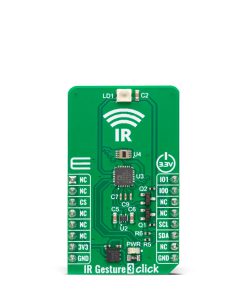Subtotal: R335.00
IR Gesture 3 Click
R1,000.00 ex. VAT
IR Gesture 3 Click is a compact add-on board that provides contactless gesture recognition. This board features the ADPD1080, a photometric front-end from Analog Devices. The IR Gesture 3 Click allows gesture recognition in two dimensions, with a built-in optical filter and a sharp visible light cutoff. It eliminates the need for external lenses and preserves the dynamic range of the sensor when placed under sunlight or indoor lighting. It does not require a precise alignment because its sensor maintains a linear response within the ±35° angular field of view. This Click board™ makes the perfect solution for the development of various gesture sensing applications, from hand swipe gestures (left, right, up, down, wave), air click, and flicks to multizone proximity detection.
IR Gesture 3 Click is fully compatible with the mikroBUS™ socket and can be used on any host system supporting the mikroBUS™ standard. It comes with the mikroSDK open-source libraries, offering unparalleled flexibility for evaluation and customization. What sets this Click board™ apart is the groundbreaking ClickID feature, enabling your host system to seamlessly and automatically detect and identify this add-on board.
Stock: Lead-time applicable.
| 5+ | R950.00 |
| 10+ | R900.00 |
| 15+ | R850.00 |
| 20+ | R818.00 |

 HYDROGEN Click
HYDROGEN Click 















.jpg)








